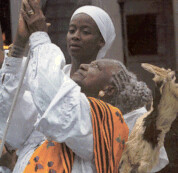
New York's African Burial Ground was opened with a ceremony in 2003. It has been dedicated as an historical site.
Originally uploaded by Pan-African News Wire File Photos
By VERENA DOBNIK Associated Press Writer
Updated: 02/27/2010 05:54:36 PM PST
NEW YORK—About 15,000 African slaves and their descendants were once unceremoniously buried under what is today Manhattan—and forgotten.
On Saturday, a new visitor center opened near the rediscovered cemetery from the 17th and 18th centuries to celebrate the ethnic Africans who had toiled, many unpaid, to help make New York the nation's commercial capital.
"It's shocking—the number of people today who are still unaware that this history exists in New York," said Tara Morrison, superintendent of the African Burial Ground National Memorial.
It's located a short walk from Wall Street, where African slaves once were traded.
Some of their remains were exhumed after 1991 and reburied on a third of an acre surrounded by high-rises amid bustling lower Manhattan.
The visitor center on Broadway opened Saturday afternoon after a ceremony that included remarks by Howard Dodson, director of Harlem's Schomburg Center for Research in Black Culture.
"People say the South was evil, keeping slaves, and that the good people of the North were opposed to it," Dodson said. "The truth is, New York was just as involved; this city's economy was tied to slavery, and New York merchants financed the South's cotton trade."
The street-level center offers interactive exhibits showing that the African labor force was crucial to the prosperity of Dutch-colonized New Amsterdam in the 1600s, and later New York, governed by the English until the American Revolution. In 1776, there were about 25,000 people living in New York, about one-fifth of them slaves.
The slaves had come off ships from Africa and the Caribbean, landing in Perth Amboy, N.J., a busy duty-free port for the importation of slaves—men and women practicing Christian, Muslim and traditional African faiths.
They worked on docks and made roads or did farm and domestic work. The skilled artisans and craftsmen were associated with shipping, construction and various trades.
Some remained enslaved, while others gained some degree of freedom and could raise their families, though none had the full rights of the colonists.
But all were among those building a new nation.
When these early New Yorkers died, they were wrapped in shrouds and buried on more than 6 acres of land beyond the then official northern boundary of the city, at today's Chambers Street in lower Manhattan. Only non-Africans could be buried in the city proper.
After the 1741 slave insurrection, 18 slaves were hanged and 13 burned at the stake on vague charges of arson and conspiracy.
At the entrance to the visitor center is a burial scene with life-size figures, "to remind people that they are visiting a sacred site," Morrison said.
The forgotten burial place was rediscovered in 1991, when construction began on the foundation of a federal office building. The remains of about 400 men, women and children were found 20 feet underground.
Photos of individual graves, with skeletal remains, fill a wall of the new center.
Each is numbered, with descriptions of what people suffered while alive, based on scientific analysis.
"The bones show that they were overworked and malnourished, and some show signs of trauma," said Michael Blakey, a physical anthropologist and the scientific director of the African Burial Ground Project.
Slaves were raped, lynched and beaten at various times, according to historic accounts.
Even slave children were used as labor, some separated from their families and sold to the New York colonists.
The government building was redesigned to accommodate the memorial, and in 1993 the Burial Ground became a National Historic Landmark.
President George W. Bush signed a proclamation in 2006 designating it a National Monument as the "most important historic urban archaeological project undertaken in the United States." A memorial was dedicated the following year.
Opening to the public Saturday afternoon, the 6,700-square-foot space has four exhibit areas, a theater and a gift shop.
The African Burial Ground is part of the National Park Service, and there's no entrance fee.
It took almost two decades to officially preserve the site, after an emotionally charged battle pitting scholars, activists and officials against those arguing that business in the densely built-up neighborhood would be disrupted during excavation.
The rest of the original cemetery under existing buildings remains untouched.
The visitor center also will examine the preservation efforts, said Morrison, adding that they reflect "the importance of citizens taking action."
She said she's seen adults at the Burial Ground who looked "very angry, because they're learning this history for the first time. Now they'll know when they walk down Broadway: This is our complex, collective heritage."
New York abolished slavery in 1827.
---------------------------------------------------------------------------———
African Burial Ground National Monument:
http://www.nps.gov/afbg/index.htm
No comments:
Post a Comment